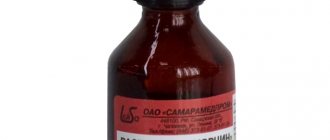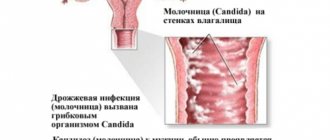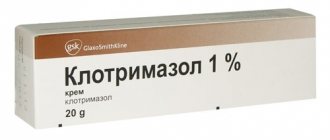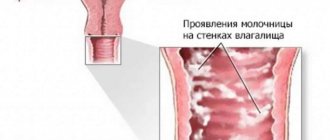Genital thrush in children
Genital thrush in children is common. This disease provokes the proliferation of the Candida fungus. This disease is difficult for children to tolerate. To complicate the situation, they can reinfect themselves if they are not monitored. This significantly prolongs therapy. Sometimes thrush becomes chronic; to prevent this from happening, consult a doctor.
https://youtu.be/Uq53JN7qcos
Why does it happen?
A child can only become infected from an adult.
Most often, thrush in children in the groin area occurs at a young age. Thrush in newborns can be transmitted from the mother during childbirth. The baby's immune system is not yet strong enough to fight this disease. Candidiasis in children under one year of age is also transmitted through mother's milk. This disease also occurs in older children. In this case, the fungus is transmitted if children's clothes are washed with adults' clothes, through unwashed food and dirty hands. In addition, this disease can be caused by a disorder of carbohydrate metabolism.
Symptoms in babies
Thrush on the skin manifests itself a little differently than many women are used to imagining, for example, candidal colpitis. The main symptoms of fungal infection in the groin area are as follows:
- red spots of varying sizes, often weeping;
- itching and burning in the area where they appear;
- a white coating may be detected;
- the spots are painful, including when touched;
- there may be, but not always, a sour odor in the affected area;
- the infection may spread to the area of the vulva and vagina, urethra, in which case whitish, cheesy discharge may occur in these places;
- the areas of the spots and the surrounding tissue are swollen.
In newborns and one-year-old children, inguinal candidiasis may look like miliaria or dermatitis; standard treatment in this situation will not be as effective.
Treatment of candidiasis
As in adults, treatment depends on the stage and state of the immune system. Thrush can be treated in 2 ways:
- medicines;
- traditional medicine.
In addition, treatment will be effective if you adhere to a diet. It is important to remove foods from your diet that promote Candida growth. These include:
- sugar;
- fruits;
- baked goods (anything that contains yeast).
Return to contents
Medication
Treatment for a newborn girl is difficult, since suppositories need to be inserted into the vagina. This is very inconvenient and experts advise using ointments. They are easy to smear on the labia for thrush in girls and pussy in boys. The most popular drugs are discussed in the table:
Causes of thrush
Yeasts are opportunistic pathogens. Normally, the vagina has a slightly acidic environment. This prevents the active proliferation of fungal flora.
In many women, when examining vaginal secretions, Candida fungus is detected, but there are no symptoms of thrush. They enter the genital tract from the intestines, through contact with contaminated objects, or sexual relations with carriers of fungal microflora.
What to do if you have thrush?!
Read more >> |
Colpitis (inflammation of the vaginal mucosa) due to the active proliferation of Candida fungi occurs under certain conditions. Favorable factors for the appearance of thrush are:
- changes in hormonal levels (for example, when taking contraceptives, menstrual irregularities, pregnancy);
- taking antibiotics;
- in young girls, the cause of thrush is poor nutrition (diet, lack of vitamins, excessive amounts of carbohydrates);
- insufficient personal hygiene;
- wearing synthetic underwear, using panty liners are additional factors that create a favorable environment for the growth of fungi in the vagina and provoke thrush;
- metabolic disorders, excess weight;
- constant stress;
- hypothermia;
- endocrine pathologies (diabetes mellitus, thyroid problems);
- In girls, thrush develops during puberty, when sudden hormonal changes occur in the body.
The likelihood of developing thrush increases with vaginal dysbiosis. Normally, a woman’s genital tract contains 90% lactobacilli, 9% bifidobacteria and 1% opportunistic microflora (Candida fungi, mycoplasmas, ureaplasmas, gardnerella). Changes in the ratio are a consequence:
- long-term treatment with antibiotics;
- hormonal disruptions (during pregnancy, childbirth, abortion, menopause, incorrect hormonal contraception);
- intestinal dysbiosis;
- any infectious, viral inflammation of the pelvic organs.
In severe cases, vaginal dysbiosis leads not only to candidiasis, but also to cervical pathologies and infertility.
Genital candidiasis is often a marker of sexually transmitted diseases. Thrush cannot be considered a sexually transmitted infection, but disordered sexual contact increases the likelihood of fungal proliferation and concomitant infection with pathogenic bacteria, microorganisms, viruses (causative agents of gonorrhea, syphilis, herpes, chlamydia, trichomoniasis, HIV).
Thrush more often develops in women with reduced immunity due to chronic diseases and malignant neoplasms.
Vaginal candidiasis is detected not only in teenage girls and adult women, but also in children. If a pregnant woman has thrush, the infection can be passed on to her daughter during childbirth. In the future, fungal candidiasis occurs due to:
- insufficient hygiene;
- severe allergic reactions;
- frequent ARVI;
- infection with pinworms (worms that cause enterobiasis).
Routes of infection
Thrush is not an infection that can only be transmitted sexually, so the disease occurs in both adult women and girls under 12 years of age and those who are not yet sexually active.
Infection can occur:
- during childbirth when passing through the birth canal, if the mother did not undergo pathology treatment during pregnancy;
- with unsatisfactory hygienic care of the genitals;
- with low immunity;
- through common soap and towel.
Causes
What can cause an increase in the growth of colonies of the Candida fungus and lead to thrush in girls and how is this disease treated?
First, let's look at the most common reasons:
- general somatic infectious processes;
- impaired blood supply to the pelvic organs;
- pathology of endocrine genesis;
- agranulocytosis;
- development of anemic conditions;
- disturbance of intestinal microflora;
- vaginal dysbiosis.
Symptoms
Thrush often manifests itself in the form of vulvovaginitis, affecting the vestibule of the vagina, labia and vulva.
The disease brings severe discomfort to the child, which is manifested in the following:
- burning and severe itching felt in the genital area;
- swelling and swelling of the vaginal mucosa;
- hyperemia of the external genitalia;
- the appearance of white-yellow cheesy discharge with an unpleasant odor;
- the formation of light plaque on the genitals;
- Sometimes there is pain during urination.
Thrush after taking antibiotics
As you know, thrush appears quite often in a child after antibiotics. And this is not surprising. The purpose of antibacterial drugs is to eliminate pathogenic microorganisms, and therefore, the wider the spectrum of action of the drug, the more complications can develop after its use.
If a child develops thrush from antibiotics, then it is necessary to immediately choose another treatment option. After all, the effect of the drug begins in the intestines, inhabited by bacteria that promote the digestion of food and die in a short time under the influence of drugs. The space freed from bacteria is occupied by opportunistic and pathogenic microorganisms, including fungi of the genus Candida.
In addition, the antibiotic is absorbed into the blood, which means it reaches the mucous membranes of the mouth and genitals, which also promotes the growth of fungal flora that is insensitive to the effects of the drugs. Candidiasis manifests itself after antibiotics in a child in the same way as its other types - by the presence of a white coating on the mucous membrane of the mouth or genital organs.
Chronic thrush
Chronic candidiasis is characterized by a less pronounced manifestation of the symptoms of the disease. If a girl did not receive timely treatment or did not see a doctor at all, then the process usually intensifies before her critical days.
Chronic forms of thrush have the following symptoms: the skin and mucous membranes become reddish-brown in color, and wrinkles appear on the labia. In children with such symptoms, it is often possible to detect manifestations of disease in other organs - the intestines, oral cavity or tonsils.
Prevention of thrush
There are three main approaches to prevention:
- Nutritional. Refusal of foods that are prohibited to be consumed during treatment of the disease.
- Medical. Do not take any medications without a doctor's prescription. During sexual intercourse, use a condom. Treat chronic diseases in a timely manner.
- Hygienic. Refusal of synthetic underwear. Do not use soap to wash your face more than once a day. Do not douche unless necessary.
In addition, it is necessary to lead a healthy lifestyle. And don't have sex too early. By following these simple rules, you can protect yourself and your children from the appearance of thrush.
Diagnostics
Before treating thrush in a little girl or teenager, the doctor needs to conduct a comprehensive examination, which includes:
- gynecological examination;
- taking swabs for testing;
- ultrasound diagnostics of the pelvic organs.
If, during an external examination, a specialist detects redness or swelling of the vaginal mucous membranes, then the presence of candidiasis can be confirmed using microscopic and laboratory tests (ELISA, PCR, bacteriological culture).
Thanks to such methods, it is possible to detect candida fungi, as well as carry out differential diagnosis with other possible types of pathogens.
Ultrasound examination makes it possible to determine the extent of the disease and the involvement of other organs.
Possible complications
If genital candidiasis is left to chance, fungal agents will readily enter the general bloodstream and reach the intestines, throat or mouth, bladder, and begin active reproduction and the formation of their colonies. The possibility of candida damage to the lungs, kidneys, heart, and brain cannot be ruled out. Also, if you do not pay attention to the signs of thrush in girls on the genitals, the following may occur:
- fusion of the labia, which in the future will not allow her to become pregnant and give birth to a baby;
- disturbances in intestinal function, poor absorption of nutrients necessary for the normal functioning of the body;
- strokes, heart attacks.
Fungus in the mouth
Fungal infections in the oral cavity are most often observed in little girls under the age of one year due to a very weak immune system, which simply does not have enough strength to fight the causative agents of the disease - yeast fungi. First, small red spots appear on the baby’s tongue, which are soon covered with a white coating that looks like cottage cheese. Gradually, representatives of opportunistic flora affect the palate, the inside of the cheeks, and the mucous membrane of the lips. If treatment is not treated in a timely manner, the lesions increase in size and plaque becomes more and more strongly attached to the mucous membrane.
If at a mild stage the curdled consistency can be easily removed with a cotton swab or gauze swab, in the case of a moderate form this procedure is much more difficult to carry out. The severe stage is characterized by a solid white film covering the baby’s oral cavity. The plaque practically cannot be removed; any attempts to get rid of it bring significant discomfort to the child. Basically, all the signs of thrush prevent the baby from calmly sucking milk, eating, sleeping, and cause irritability, tearfulness, and restlessness.
Treatment
As with any other disease, treatment of thrush in girls should only be carried out under the supervision of a doctor. Measures taken independently can lead to aggravation of the process, and sometimes even to complications.
There are several directions in the treatment of candidiasis:
- Local treatment. Antifungal medications and antiseptics are usually prescribed and are used to treat the external genitalia. Among them are Chlorhexidine, Miramistin, Levorin, Clotrimazole.
- Systemic treatment. Prescribed for severe candidiasis and its relapses. For treatment, oral administration of Diflucan (at the rate of 3-7 mg per 1 kg of body weight) or other antifungal agents is recommended.
- Strengthening the immune system. Carrying out immunocorrection for a course of at least 28 days. Ingestion of eleutherococcus or rosea radiola infusion, 30 drops at least 2 times a day.
- Effect on microflora. Children usually do not require probiotics to restore microbial balance, but in some situations, after a pronounced illness, gynecologists prescribe Lactobacterin, Acelactate or similar drugs.
What can be done to prevent a child from getting thrush?
Firstly, it is necessary, even during pregnancy, before childbirth, to sanitize the vagina with drugs prescribed by the doctor.
Secondly, before each breastfeeding, the mother should wash her breasts so as not to introduce any infection to the delicate mucous membrane of the baby’s mouth. After each feeding, you need to give the baby a little boiled water in order to wash away the remaining milk from the mouth.
Milk is a breeding ground for many infections. You should also rinse your baby's mouth after burping. During regurgitation, the acidic environment of the stomach can enter the oral cavity; such an environment contributes to the rapid development of thrush.
Thirdly, all nipples, bottles, dishes and toys of the baby must be sterilized. Moreover, the child must have an individual towel, which must be changed 1-2 times a week.
Change diapers every 4-6 hours and arrange “air baths” more often so that the skin breathes and there is no diaper rash.
Fourthly, when taking antibiotics, do not forget about the possibility of thrush, and from the first day of treatment for the underlying disease, use probiotics internally (Bifidumbacterin, Lactobacterin, etc.).
Traditional methods
To remove the symptoms of thrush, you can use traditional methods in combination with traditional treatment of candidiasis, but only after consulting a doctor.
The following decoctions are most effective for washing the external genitalia:
- Infusion of medicinal marigolds. Pour 20 grams of dried flowers with a liter of boiling water and place in a dark place to infuse.
- St. John's wort decoction. 3 tbsp. l. Pour dry collection into an enamel pan, add 2 liters of water, put on fire and bring to a boil.
- A decoction of linden and oak bark. For 3 parts of flowers, take 1 part of oak bark and pour boiling water over it. After infusion, use for washing.
Treatment of thrush in a child in the groin
To rid your baby of candidiasis and avoid further relapses, first of all, you need to pay attention to the immunity of the “young patient”. Taking vitamins, proper feeding and maintaining hygiene can help you forget about the disease for a long time.
To treat thrush in a child in the groin, drugs for general and local treatment are used, as well as more gentle, but also less effective traditional methods of treatment.
Medications
If the skin is slightly affected by the fungus, there is a possibility that the disease can be overcome by using only local remedies.
In this case, it is recommended to treat the child’s skin and mucous membranes with solutions that have an antifungal and disinfectant effect (Miramistin, Fukortsin), and apply antifungal ointments, which include cortisone, nystatin, imidazole derivatives (Miconazole, Econazole, Polygynax, Natamycin, Ketoconazole, Pimafucin, Nystanin, Clotrimazole, Levorin, Terbinafine, Amphotericin B). Drugs and treatment regimens will vary depending on the severity of the condition and the age of the child.
Typically, the course of treatment for candidiasis in children in the groin takes from 5 to 10 days. It should be remembered that an unfamiliar drug may have a number of contraindications and cause unexpected side effects. Therefore, treatment of thrush should be strictly under the supervision of a pediatrician, who will competently prescribe medication, eliminating possible risks of complications.
Thus, it is undesirable to use in the treatment of a solution of brilliant green, which dries out the delicate skin of a child, a solution of sodium tetraborate, which has a toxic effect (up to 1 year), and Fluconazole, recommended for use after 18 years.
If the disease has entered the middle or late stage, the child is prescribed systemic treatment. Narrowly targeted antifungal therapy in this case is much preferable, since complex agents negatively affect the microflora of the intestines and stomach. In parallel with antifungal drugs, probiotics, B vitamins, and vitamin C are prescribed, as well as other medications that enhance immunity.
If the use of medications is undesirable (allergic reactions, age up to 6 months), treatment with folk remedies will come to the rescue, which can be harmful only in rare cases.
Folk remedies
Among the folk remedies used in the treatment of thrush in a child’s groin, the most effective are:
- treating the skin 2-3 times a day with a weak soda solution (1 tsp soda per 1 glass of water);
- treating the skin in the groin folds, lower abdomen and between the buttocks with a disinfectant infusion of chamomile, St. John's wort, calendula and sage 3 to 6 times a day (a teaspoon of dry raw materials (or 1 filter bag) is poured with a glass of boiling water and infused for 30 minutes);
- compresses with Kalanchoe - squeeze a little plant juice onto a bandage, apply to damaged skin 2-3 times a day for 10 minutes.
Combining antifungal medications with traditional medicine has an enhanced effect on the disease, which leads to a speedy recovery and reduces the frequency of relapses of candidiasis in children.
Prevention of the appearance and development of thrush is also of considerable importance.
Prevention
The best way to prevent the need to treat thrush in adolescents and girls at any age is to prevent candidiasis.
Performing simple hygiene procedures and following certain rules will reduce the likelihood of developing this disease.
Necessary measures include:
- Wearing underwear made from natural materials.
- Avoid taking antibiotics without a doctor’s advice, as this can destroy not only pathogenic, but also beneficial microflora of the body.
- Balanced diet with limited sugar intake.
- Complete exclusion of nicotine and alcohol, which have a detrimental effect on the growing body.
- Abstinence from early sexual contact.
- Compliance with genital care.
Every mother should instill in her daughter the basics of personal hygiene, which will provide protection from various diseases that affect the reproductive system.
If pathology does occur, then a timely visit to the doctor will quickly stop the development of the process and prevent complications.
Author: Violeta Kudryavtseva, doctor, especially for Mama66.ru
Forms of the disease
Thrush in girls can occur in different ways, it all depends on the duration of the disease and the nature of the symptoms detected. Gynecologists distinguish:
- Sharp form. Appears after a provoking factor, due to decreased immunity. Usually accompanied by vivid symptoms characteristic of vaginal candidiasis - discharge, burning, intense itching. With proper treatment started in a timely manner, the disease goes away without leaving a trace, leaving no complications.
- Chronic course of candidiasis. Sluggish thrush with periods of attenuation of the inflammatory process and exacerbations, recurring on average 4 times a year. This form of the disease occurs after untreated acute thrush and with improper therapy with antifungal agents.
It is important to correctly diagnose the disease and begin effective treatment on time, because chronic thrush can lead to a number of serious complications - damage to the internal genital organs, cervix and infertility.
Causes
Thrush (candidiasis) is one of the forms of manifestation of the activity of yeast-like fungi of the genus Candida: the still weak immune system cannot cope with their intensive reproduction. There are several main factors that contribute to the manifestation of thrush in a child in the groin.
The reasons are as follows:
- Infants most often become infected from their mother during childbirth, if she has not cured candidiasis. The risk of such infection from the medical staff of the maternity hospital is also not excluded.
- The use of shared diapers, pacifiers, bottles or dishes, and contact with sick children often lead to accelerated division of fungi (proven fact).
- Being in wet diapers and diapers creates an ideal environment for the development of pathogenic microflora, which includes milk disease.
- The presence of chronic or acute diseases and conditions leading to decreased immunity (dysbacteriosis, vitamin deficiency, diabetes mellitus, colds), as well as pathologies of child development.
- Hormonal changes in the body can weaken the child’s immunity, which means making him more vulnerable to candidiasis pathogens.
- Frequent consumption of sugary foods and drinks accelerates the division of yeast-like fungi, which, even with a minimal decrease in immunity, can lead to thrush.
- Taking antibiotics (applies to older children), which have a detrimental effect on the intestinal microflora and are often a consequence of an immune failure.
Thrush in the groin area in a child is most often the result of unresolved symptoms of a fungal infection of the oral cavity, which, once developed, can affect the nails, skin, groin area, buttocks and internal organs. Therefore, it is very important to consult a doctor at the first suspicion of candidiasis - treating the child independently can transform the disease into a stable chronic course.
In order not to miss the onset of the development of candidiasis in the groin area in children, it is recommended to carefully examine the skin and mucous membranes after bathing.
Causes of thrush in children in the groin area
Thrush is the common name for candidiasis in any area.
It can be found in the mouth, in the intestines, in the folds of the skin, as well as on other mucous membranes, such as the vagina. In a child who is not yet fully strengthened, candidal fungi can actively multiply in areas of high humidity and high temperature, for example, in the groin. Thrush in this area can occur in newborns and one-year-old children, as well as in older ones. Additional provoking factors for this may include the following factors:
- Reduced immunity, for example, due to intrauterine infection or serious illness.
- Prolonged exposure to the airless, humid and very warm environment of the diaper, especially if it is very hot outside or indoors.
- Chronic diseases - thyroid gland, diabetes, leukemia and others like that, which lead to a decrease in the child’s body’s defenses.
- Long-term use of certain medications - antibiotics, cytostatics, hormonal drugs.
The harm of diapers
Foci of thrush in the groin area can occur in a child if there is an infection in other places - in the mouth, intestines. Fungi enter the groin area due to poor hygiene due to immunodeficiency. Infection from a sick mother is possible if she also neglects basic hygiene rules. However, more often than not, thrush is the result of activation of one’s own opportunistic flora, because fungi are constantly on the skin of a baby and any person, but the body’s defenses prevent the infection from activating and clinically manifesting itself.
Any treatment should begin with an accurate diagnosis, and this requires an examination by a specialist - a pediatrician or dermatologist. Additionally, to confirm the presence of fungi, a smear should be taken from the affected skin. When a secondary infection occurs in the area of inguinal candidiasis, a yellowish coating and ulceration may appear.
In any case, treatment includes not only the use of medications, but also compliance with special rules of hygiene and nutrition.
Treatment will depend on the extent of the process. In case of a generalized form and damage to other areas, systemic therapy with drugs based on fluconazole, nystatin and other antifungal agents may be prescribed.
If only the groin area is affected, local antifungal therapy may be limited. Creams and gels are used based on the following active substances:
- Natamycin;
- Sertaconazole;
- Miconazole;
- Nystatin;
- Clotrimazole and others.
Additionally, the following measures should be observed:
- minimize the child’s stay in a diaper, if possible replace them with cotton diapers;
- arrange air baths more often;
- You should avoid soap and other hygiene products until complete recovery, and limit yourself to washing with warm water, using a chamomile infusion.
Expert opinion
Daria Shirochina (obstetrician-gynecologist)
It is also recommended to treat the affected areas with a soda solution. To do this, take a tablespoon of baking soda and dissolve it in 200 ml of water. Moisten a cotton swab and wipe the groin area several times a day.
Treatment of adolescents
Treatment can also be combined - local use of ointments plus systemic administration of antibacterial drugs, or in some cases it can be limited to only ointments, suppositories and hygiene.
The following groups of drugs are used:
- local ointments, gels, creams - based on the same active ingredients, Natamycin, Miconazole, Sertaconazole, Clotrimazole and others;
- you can treat the affected areas with soda solution;
- when vulvitis and colpitis occur in girls, you can use suppositories with an antifungal effect, some of them have a special shape for those who are not sexually active.
Additionally, adolescents should be provided with stress-free conditions - protected from excessive stress, mental overstrain, and provided with adequate nutrition with the exception of sweet foods.
Expert opinion
We suggest you familiarize yourself with Warts in the groin in men: causes and treatment
Daria Shirochina (obstetrician-gynecologist)
Episodes of candidal vulvitis, vulvovaginitis, and inguinal candidiasis in girls may be the first manifestation of the latent course of diabetes mellitus. Therefore, if symptoms are detected, the first thing you should do is take a blood glucose test.
Folk remedies
It is useful to supplement treatment with folk recipes. For example, you can use the following:
- Take baths with medicinal herbs. They will soothe the skin, relieve inflammation, and accelerate healing. For this you can use chamomile, calendula, string, sage, eucalyptus and others.
- The same herbs can be used to make compresses on the groin area.
- Kalanchoe. They also have a wound healing and soothing agent. It is necessary to take old leaves, squeeze the juice out of them and lubricate the affected areas.
Symptoms and signs
Often the onset of thrush does not cause complaints, so the first symptoms may go unnoticed by parents. However, by the time candidiasis affects the groin area, signs of the disease are visible to the naked eye.
Symptoms of candidiasis in the groin:
- itching, burning and severe discomfort;
- swelling of the external genitalia;
- redness, weeping spots with clear contours;
- a small rash with a white tip in the groin folds, on the buttocks and lower abdomen;
- white coating on the mucous membrane of the genital organs with a specific odor;
- white discharge, with a consistency similar to cottage cheese, from the vagina or urethra.
This is what candidiasis in children looks like in the groin. In addition to this, thrush may be accompanied by fever, moodiness, apathy, and loss of appetite.
Thrush in children in the groin in the photo
And now we offer you a few photos. Thrush in children in the groin looks exactly like this:
Diagnosis and symptoms
The first signs of thrush in a child are not so difficult to notice. Attentive parents can detect the presence of the disease in the early stages. Infants cannot yet tell mom and dad about the reasons for their illness, so it is important to monitor all manifestations of the child’s condition. Among the external manifestations of candidiasis in a child, the following may be observed:
- In boys, a small, cheesy discharge appears from the urethra. In girls, similar discharge appears between the labia. Sometimes in boys, thrush can lead to swelling of the glans penis.
- A rash consisting of small blisters that can sometimes be confused with hives or miliaria. The main difference between a candidal rash is in its location: the pubic area, buttocks and anus, in the folds of skin adjacent to the groin area. The rash is itchy and itchy, so your child may scratch the blisters into painful plaques.
- A sour smell from the genitals that does not disappear even after washing.
- Painful urination. The child tries to hold back the flow of urine, as the process causes inconvenience and pain.
- Child restlessness, loss of sleep. The baby tries to touch or scratch in the groin area, where the main source of his anxiety is. Appetite is impaired only if the fungus has spread to the oral cavity. It is easy to notice: a white, cheesy coating appears in the mouth, underneath which there is inflamed mucous tissue.
We suggest you familiarize yourself with what ointments to treat atopic dermatitis in a child?
https://youtu.be/D6dl754XG1E
When the first signs of thrush appear in the baby’s groin, parents should immediately consult a doctor. After examining the child, the pediatrician prescribes the following procedures to clarify the diagnosis and prescribe treatment:
- Research using inoculation of a sample from the mucous membranes in a specific medium. The PCR method allows you to accurately identify the causative agent of the disease;
- Examination of samples under a microscope;
- Serological study. This method allows you to accurately identify the causative agent of thrush in the groin.
Treatment for thrush is not carried out until test results are received. To eliminate negative symptoms, local remedies are prescribed in the form of ointments and creams.
Any mother can suspect the first signs of candidiasis. They usually appear quite clearly and are very specific. However, if clinical signs of candidiasis are detected, you should definitely show the baby to a doctor. The doctor will conduct a clinical examination, and in some cases also additional studies for differential diagnosis.
Typically, for candidiasis infection, the following is prescribed:
- General blood analysis. Gives a descriptive picture of the presence of infection in the child’s body. It also helps to establish the severity of functional disorders. This method is indicative and does not form the basis for making a diagnosis.
- PCR. This method allows you to accurately detect the presence of fungus in various biological materials. To carry out this test, a preliminary plaque collection will be required.
- Microscoping. A high-resolution microscope can detect fungus in any environment. In some cases, for a more accurate result, doctors use preliminary staining of the material. This helps to identify the fungus even in difficult diagnostic cases.
- Serology. Using RSC and the agglutination reaction, candida fungi can be detected in urine, blood, eye discharge, vaginal plaque and other secretions. In some cases, this method is used to identify visceral forms of candidiasis or after a spinal puncture.











